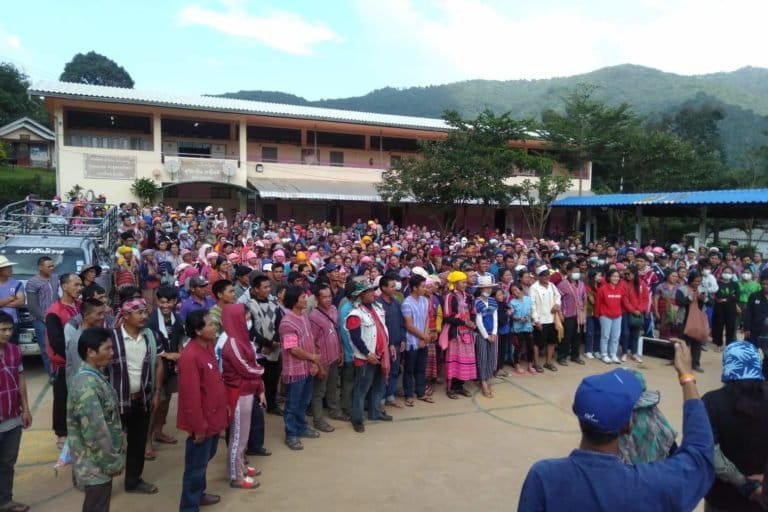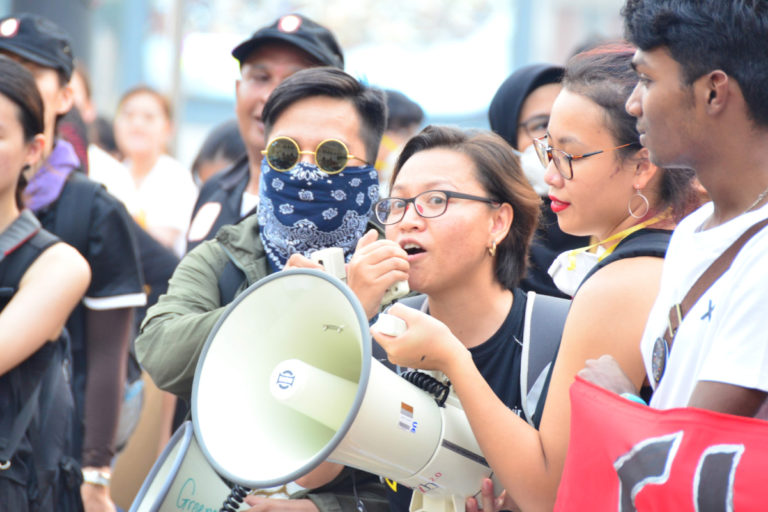- In Asia, environmental youth activism has expanded beyond climate strikes and into action, advocacy and education.
- In Thailand, Pornchita Fahpratanprai and her community are battling to stop the construction of a new coal mine project.
- In Malaysia, Ili Nadiah Dzulfakar is improving climate literacy among the public, while Pradeep Karuturi is educating schoolchildren across India about climate change.
Nineteen-year-old Pornchita Fahpratanprai had never participated in a climate strike before. High up in the mountains of Omkoi district in Chiang Mai, Thailand, far from Facebook and Instagram posts of protests and demonstrations, she had been helping her mother cultivate farmland.
In the indigenous Karen community of Kabue Din that she’s part of, she led a tranquil and simple way of life growing crops on fertile soil with pristine waters and fresh air.
That changed when Fahpratanprai and members of her community discovered that the livelihoods they had long cherished and protected were now under threat.
Giving voice to the locals

“During 2000 and 2001, a mysterious group of people had come in to buy property from Kabue Din locals without making any clear statements about what they intended to do with it. The story had quieted down until May 2019, until rumors about a coal mining project spread through word of mouth,” Fahpratanprai said in an email in Thai.
Locals found out the proposed project, expanding over roughly 45 hectares (111 acres), was approved by the government since 2011. Fahpratanprai thinks that the environmental impact analysis (EIA) report — a 500-page document released in 2000 — however, was “not up to standards or transparent.” According to her, several community members’ names appeared on the report repeatedly, despite their absence from the meetings mentioned. Some names were of residents from other areas, and some of minors. On top, the assessment described the land as “degraded forest,” despite its pristine condition as a river source.
The announcement only came late last year, and eschewed any discussion or explanation to the locals about the impacts of coal mining. Like in countless communities affected by coal mines, this new project has been criticized for the potential for damage to human health, the area’s ecosystem, and the health of agricultural land and traditional lifestyles.
It didn’t take long before the story spread across Omkoi district and Chiang Mai province, and soon enough, communities and organizations gathered to form a new coalition named “Network to End Coal Mining in Omkoi.” Together, they exchanged knowledge and ideas about the effects of the proposed coal mine, with Fahpratanprai relaying information to locals and coordinating with other youth members, to compile a document calling on the government to re-evaluate the project.
They submitted their request earlier this year, and in September more than a thousand community members attended a hearing. The crowd was so huge they had to relocate the meeting.
“Over two months have passed, and we still have not heard back,” Fahpratanprai said. But they are not giving up.
“When there’s the second hearing, we the youth, locals and community members of Omkoi are ready to stand up to fight and say no to the coal mine that will [contribute to] climate change, and [cause] the lands and lifestyles we’ve passed down from our ancestors to disappear,” Fahpratanprai said.
Despite concerns about carbon emissions and climate change, new coal mines continue to flourish across Southeast Asia. But without the consent of local communities, these projects will, too, continue to face opposition from people whose homes they pollute.
Bringing knowledge to the masses

South of where Fahpratanprai lives in Thailand, Ili Nadiah Dzulfakar, too, is working with her youth activism group, called Klima Action Malaysia (KAMY), in their push for the climate agenda in Malaysia.
“[KAMY] aims to smash the political and media silence on what seems to be the beginning of the 6th mass extinction of the planet. In line with the ethos of SDG 13: climate action, KAMY aims to battle climate illiteracy at its roots,” Dzulfakar said in an email.
She and her team run workshops, panel discussions and documentary screenings aimed at educating, training and empowering school and university students, as well as encouraging front-line communities to get involved in climate activism.
To do so, they have to not only translate English climate-related terminology from organizations like the U.N. Intergovernmental Panel on Climate Change (IPCC) into easily digestible Malay and Mandarin, but also into visual forms like videos, murals and infographics. To give a human face to the climate crisis, they also collect anecdotes from local indigenous communities to illustrate their vital role in forest protection, in a country where the $60 billion palm oil industry has caused almost half of the forest loss in Borneo since the year 2000.
Now, KAMY is mobilizing an action group with partners that include politicians, media, academics, NGOs and the general public across Southeast Asia to battle the haze crisis sparked by forest burning in Indonesia, while also running bi-monthly climate strikes.
“Victory seems far, but not elusive. KAMY has sparked a climate discourse amongst groups of diverse background and inspired not only the youth but everyone, to come forward and plan for their own initiative,” Dzulfakar said. “Although baby steps, I think this is a positive development from a nation where climate illiteracy is high.”
Creating hope for the children

Nearby, in India, Pradeep Karuturi is empowering more youth to take those first steps. In January this year, he and his friend Amar Akbar set off on a grueling, yet rewarding, three-week journey pedaling more than 2,000 kilometers (1,200 miles) — through sun and rain, “inhabitable forests and barren lands,” up hills and enduring punctured tires — across all 13 districts of Andhra Pradesh state in India to speak about climate change to more than 5,000 kids in 35 schools.
“I strongly believe children are important stakeholders in climate action and can influence their communities to take positive action on climate change,” Karuturi, now 26, said. In the six years that he’s been working on the environment and education, he has been able to garner the support and help of his friends to achieve what the government has been unable or unwilling to.
He’s taught students, as well as many teachers, farmers, families and public officials whom he met along the way, about sustainability. From tree plantations, waste reduction, rainwater harvesting, power saving and organic farming, to design thinking, leadership and problem solving, Karuturi has made several schools and communities eco-friendly — starting from just a bicycle, a friend and an ambition.
Like climate activists in Asia and around the world, he, along with Dzulfakar and Fahpratanprai have inspired action by their own deeds, with lasting impacts that have already rippled beyond their homes. They are the untold army of youths who, far from the spotlight focused on their peers at climate strikes around the world, have chosen to fight their battles at home, both drive by the same motivation: to protect the planet.